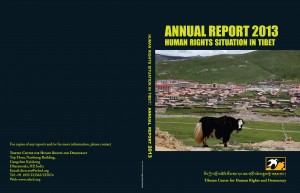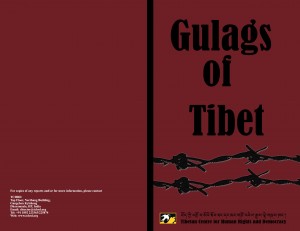
The Tibetan Centre for Human Rights and Democracy (TCHRD) is pleased to announce the release of the 2013 Annual Report on the human rights situation in Tibet and ‘Gulags of Tibet’, a special report on Re-education Through Labour (Ch: laojiao) system in Tibet.
The 2013 Annual Report, available in Tibetan and English, focuses on Civil and Political Rights, Religious Repression, Economic, Social and Cultural Rights, Religious Repression, the China’s development strategy, and self-immolations. The theme of the 2013 Annual Report is the continued implementation of nomad resettlement and relocation policy. Tibetan nomads have been forced from their ancestral lands and resettled/relocated in urban areas, mostly against their wishes and without adequate compensation. The newly built urban areas where they are forced to resettle cannot sustain their centuries-old way of life, and compared to Chinese migrant workers, nomads receive less state support in terms of finding employment and other sources of livelihood. It was widely estimated that 90% of all Tibetan nomads in Qinghai Province would be resettled at the end of 2013. Despite claims to the contrary, the primary reason for the forced relocation of the nomads is to exploit rich mineral resources from the nomadic lands. State-owned mining companies have already begun the massive extraction of precious minerals such as lithium, copper, chrome, gold and oil.
The 2013 Annual Report also includes research papers produced in collaboration with human rights students at the University of Guelph in Ontario, Canada.
The 2013 Annual Report includes fresh data from Tibet. This data consists of exclusive interviews and photographs of Tibetans living in Tibet. The interviews are of Tibetans from Amchok (Ch: Amuqu), Labrang (Ch: Xiahe), Rebkong (Ch: Tongren), Chentsa (Ch: Jianzha), Machen (Ch: Dawu), Mangra (Ch: Guinan), and Golok (Ch: Guoluo) concerning self-immolation protests, nomad resettlement, censorship, language rights and land rights.

TCHRD’s special report, ‘Gulags of Tibet’ examines the history and evolution of RTL, analyzes the current RTL laws, in addition to examining how RTL violates the international prohibitions of arbitrary detention, forced labor, and torture. The report features interviews with Tibetan RTL survivors who tell their personal stories of being locked up in forced labour camps.
In late December 2013, China announced the abolition of RTL, a form of arbitrary detention used by the Chinese government for over 50 years to imprison political dissidents and other opponents. The failure of previous reform measures to address the human rights abuses that define RTL creates skepticism as to what the abolition of RTL will actually entail. For the abolition of RTL to be meaningful it must fully abolish RTL in name and function. Since the Third Plenum various organizations have alleged that the reform will be cosmetic—simply renaming RTL facilities and expanding other forms of arbitrary detention—rather than substantive. The PRC has attempted to refute these claims,16 but until transparent action is taken that abolishes RTL skepticism will remain. Abolishing RTL in all its forms requires stopping the human rights abuses, such as arbitrary detention, forced labor, and torture, that are inherent in RTL and affect everyone in the PRC.
Please click here to read the Annual Report
And click here for the Special Report on Re-education Through Labor
